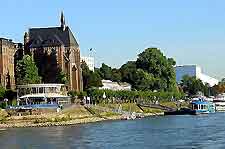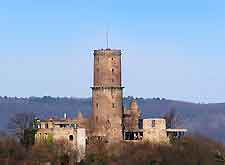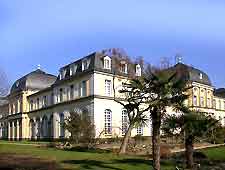Bonn Neighborhoods, Locations and Districts
(Bonn, North Rhine-Westphalia, Germany)

Bonn was previously the capital city of Germany, until the government seat moved to Berlin in 1999. The pedestrian zone dominates the city centre, with its numerous shops, regular market, historic cathedral and famous university complex, known locally as the Universität mit Hofgarten und Koblenzer Tor. However, Bonn's many other districts and neighbourhoods also offer plenty of tourist appeal.
Countless bars, breweries and eateries of all description also combine to make the city centre a lively and appealing part of the city, and this area is always buzzing. Bonn's main districts and locations are shown below.
Altstadt District
Bonn's Altstadt (Old Town) boasts an inner-city atmosphere and stretches all the way to the council office buildings in the north. A whole host of pubs and restaurants are to be found here and await those looking to have a break. Art aficionados could do worse than paying a visit to the Kunstcarré (Artists' Square) as well as the Art Forum, while other arty attractions include the Bonn Art Society on the Hochstadenring, and the acclaimed Women's Museum (Frauenmuseum) on Im Krausfeld.

Bad Godesberg District
Bad Godesberg has made a name for itself as a health resort, and the district itself also has plenty of its own attractions and charm. Near the city are the Spa Gardens, otherwise known as 'Kurpark', and the spa itself is to be found next to the Town Hall's imposing architecture. Bad Godesberg is also home to a little theatre, located in the park, together with a notable chamber theatre, where many classical concerts are often held.
Beuel District
The district of Beuel is located on the Rhine River's eastern banks, with the adjacent Kennedy Bridge linking it to the city centre. This area of Bonn is particularly famous for its carnival, also known as the 'fifth season'. Of particular interest, the Beuel district is home to a historic monument honouring the laundry women, who in the early part of the 19th century, initiated the 'Weiberfastnacht' (Women's Carnival). The Heimatmuseum Beuel also merits a visit and this museum lies on the Steinerstrasse, being otherwise known as the Beuel Homeland Museum.

Poppelsdorf District
Another typical Bonn neighbourhood is Poppelsdorf. Its charming houses date back to the latter part of the 19th century and are full of period character, making this a particularly fashionable residential neighbourhood. Surrounding the Botanical Gardens and Poppeldorfer Castle are lots of pleasant places to eat and drink, suiting most tastes.
Endenich District
The Endenich district's main claim to fame is its classical Schumann-Haus building, which is located on the Sebastianstrasse and was once home to Robert and Clara Schumann, the famous German composers. Another popular attraction within this part of Bonn is the Theater der Springmaus, where many excellent cabaret shows take place and are reputed to be amongst the best of their kind in the whole of Germany.
Ippendorf District
Nature fans will love the Ippendorf area, where the Bonn city forest is located. The highlight of the forest is without doubt the Waldau area, a popular children's centre, where an animal enclosure is waiting to delight kids. Look out for Ippendorf's House of Nature, where highlights include a range of animal exhibits and an insight into the area's wildlife.
Plittersdorf District
Bonn's Plittersdorf district is home to attractions of a different nature. Here you can find the headquarters of the Voluntary Organisation of the United Nations, located on the banks of the Rhine River, in addition to the German Museum of Bonn (Deutsches Museum Bonn) on the Ahrstrasse. The Rheinaue Park, home to the Ausee Lake, is next to Plittersdorf and offers an important recreational space.
 Bonn was previously the capital city of Germany, until the government seat moved to Berlin in 1999. The pedestrian zone dominates the city centre, with its numerous shops, regular market, historic cathedral and famous university complex, known locally as the Universität mit Hofgarten und Koblenzer Tor. However, Bonn's many other districts and neighbourhoods also offer plenty of tourist appeal.
Bonn was previously the capital city of Germany, until the government seat moved to Berlin in 1999. The pedestrian zone dominates the city centre, with its numerous shops, regular market, historic cathedral and famous university complex, known locally as the Universität mit Hofgarten und Koblenzer Tor. However, Bonn's many other districts and neighbourhoods also offer plenty of tourist appeal.
